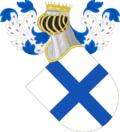Ferdinand of Portugal, Lord of Eça
This article needs additional citations for verification. (July 2016) |
Ferdinand of Portugal | |
|---|---|
| Born | c. 1378 |
| Died | , Galicia |
| Title | ' Lord of Eça ' |
| Spouse(s) | Isabel de Dávalos |
| Parents |
|
Ferdinand of Portugal (Portuguese: Fernando), later of Eça or Eza (c. 1378 – ?), was the son of Portuguese Infant João, Duke of Valencia de Campos. João, was a son of king Peter I of Portugal with powerful and literary famous for several centuries in several European languages, Galician lady Inés de Castro, "the Queen who ruled after her death".
His father, Infante John, Duke of Valencia de Campos, (Coimbra 1349-Salamanca 1397), buried there, had been legitimized as Infant of Portugal, and became Duque de Valencia de Campos in Castile through his marriage to one of the bastards of bastard king Henry II of Castile. Fernando's father John, had married in 1376, (1st marriage), Castilian lady , assassinated shortly after in 1378 by her husband, who had been alerted of her apparent unfaithfulness.
Then, he married again in Valencia de Campos in 1378 , Lady of Valencia de Campos, illegitimate daughter of bastard King Enrique II of Castile, who was therefore the step mother of orphaned Fernando of Portugal, thus becoming consort duke of Valencia de Campos.
Life[]
He was the 1st Lord of in Galicia, from where he took his surname, corrupted in Portuguese into Eça, and which was given to him by , 1st Duke of Arjona who died in prison.
Marriages and issue[]
It is said Fernando was married or perhaps lived with many wives, all of them alive.[1] Other sources say he married six times, having three or four of them alive at once, but only the name of the sixth wife is known.[2][better source needed]
Apparently, this sixth one, was Isabel Dávalos, daughter of Pedro López Dávalos, Adelantado of Murcia, and granddaughter of Ruy López Dávalos, Constable of Castile . By her he had:
- Duarte de Eça (born c. 1415), a Clergyman, who had a son by his mistress, issue apparently extinct in male line.
- Pedro de Eça, 1st Alcaide-Mór of Moura, 2nd Lord of Aldeia Galega da Merceana (c. 1430-1492), who married Leonor Casca de Camões (born c. 1420), Heiress of Moura, and had issue, apparently extinct in male line, and also had issue by unknown women, also apparently extinct in male line.
- Branca de Eça (born c. 1420), married firstly to Vasco Fernandes de Lucena (born c. 1420), by whom she had a daughter who became Abbess of the Monastery of Celas, in Coimbra, and married secondly to João Rodrigues de Azevedo, ?th Lord of a Fonte de Louro (born c. 1410), and had issue
- Inês de Eça (born c. 1450), married as his first wife to (Dom) Garcia de Sousa Chichorro (born c. 1450), and had one son
- Catarina de Eça (born c. 1440, died aft. 1515), Perpetual Abbess of the Monastery of Lorvão, who had issue by Pedro Gomes de Abreu, 5th Lord of (born c. 1440).
With Leonor de Teive, daughter of João de Teive and Brites de Horta, he had:
- Fernando de Eça, 1st Alcaide-Mór of Vila Viçosa, in the service of the Duke of Braganza (c. 1410 – Barcelos, Martim, 15 August 1501 or bef. 1513), married to Joana de Saldanha (born c. 1410), and had issue, also had a son by an unknown wife, issue apparently extinct in male line.
- Garcia de Eça, 1st Alcaide-Mór of (born c. 1410), married firstly to Joana de Albergaria (born c. 1410), and had issue, apparently extinct in male line, and married secondly as her first husband to Dona Catarina Coutinho (born c. 1440), without issue
- Leonor da Guerra or de Eça (born c. 1410), married to Galiote Leitão, ?th Lord of Torre de Ota (born c. 1410), nobleman of the Royal Household, and had issue
By another he had:
- João de Eça, 1st Alcaide-Mór of Moreira, 1st Lord of Aldeia Galega da Merceana (born c. 1420), married to Mécia de Antas (born c. 1420), and had one daughter
By another:
- Diogo of Eça (born c. 1410), married to Joana da Silva (born c. 1410), without issue
- Brites or Beatriz de Eça (born c. 1415), Abbess of the , in Coimbra, who had issue by João Gomes de Abreu, Bishop of Viseu (c. 1410 – 16 February 1482)
- Maria of Portugal, a nun at Saint Clare of Assisi in Porto
- Inês of Portugal (born c. 1415), married to Gonzalo Fernández de Hijar, 1st Lord of el (c. 1410–1450), and had issue
- Isabel of Portugal (born c. 1415), married to (born c. 1410), and had one daughter
By others:
- João de Eça (died at the Palanque de Tangiers), Commander of Cardiga.
- Diogo de Eça, died young
- Antão de Eça, a monk
- Beatriz of Portugal
- Catarina de Eça
- João de Eça (born c. 1420, died aft. 1475), married to Leonor de Xira (born c. 1420), had a son who died unmarried and without issue, had issue by unknown women, now extinct in male line.
All from different women, it is said that he had 42 children, between sons and daughters.
End of life[]
In the end of his life he repented and started wearing a rope of the Habit of Saint Francis of Assisi, with which he was buried and which appears in the Coat of Arms of his family in purple with the look of a carbuncule.
References[]
- ^ He must have had good conscience, or follow the Qur'an, in which are permitted many women. (Nobiliário das Famílias de Portugal, Tomo Décimo Terceiro, ttº Eças, Manuel José da Costa Felgueiras Gaio)
- ^ Marek, Miroslav. "capet/capet51.html". Genealogy.EU.[self-published source]
- 1378 births
- House of Burgundy-Portugal
- 14th-century Portuguese people
